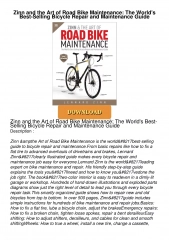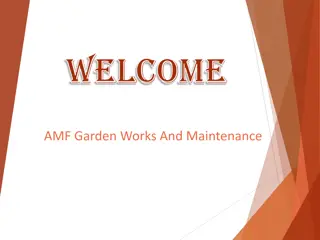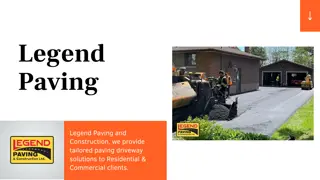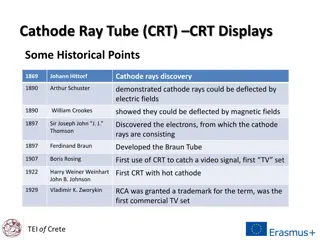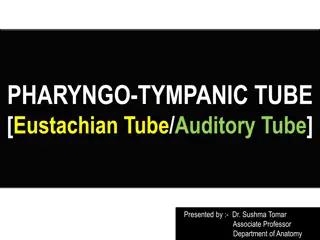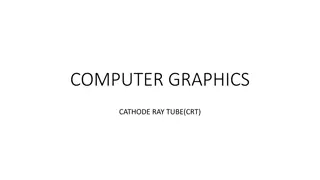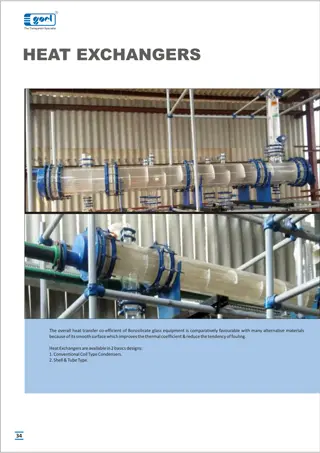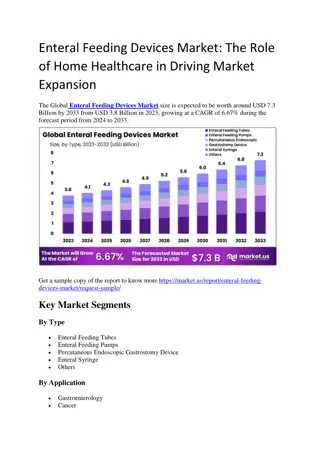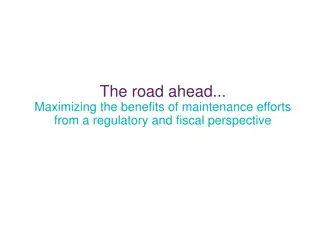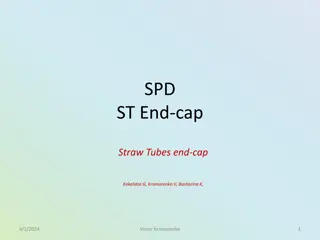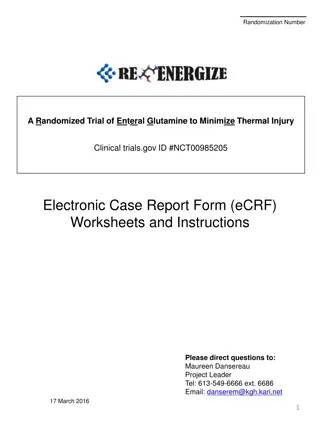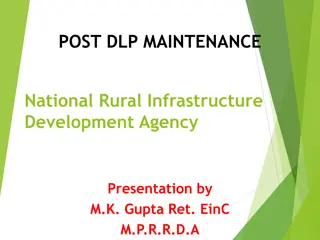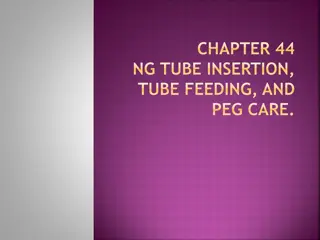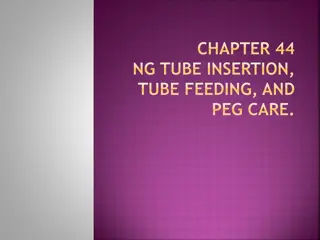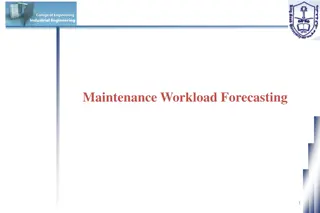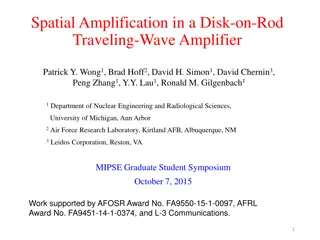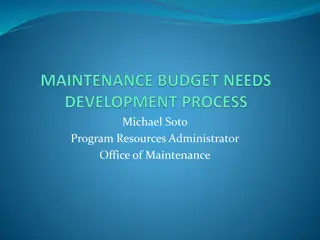Enteral Tube Use and Maintenance in Brampton and Surrounding Areas
Discover the comprehensive services provided by the William Osler Nurse Practitioner Led Outreach Team in Brampton, North Etobicoke, West Woodbridge, Malton, and Bramalea. Learn about indications for enteral tube use, different types of enteral tubes, maintenance strategies, and more. Explore essential information on types of tubes, gastric tubes, and balloon gastrostomy tube replacement procedures. Enhance your knowledge on preventing and managing enteral tube occlusion and complications.
Download Presentation

Please find below an Image/Link to download the presentation.
The content on the website is provided AS IS for your information and personal use only. It may not be sold, licensed, or shared on other websites without obtaining consent from the author.If you encounter any issues during the download, it is possible that the publisher has removed the file from their server.
You are allowed to download the files provided on this website for personal or commercial use, subject to the condition that they are used lawfully. All files are the property of their respective owners.
The content on the website is provided AS IS for your information and personal use only. It may not be sold, licensed, or shared on other websites without obtaining consent from the author.
E N D
Presentation Transcript
SERVING BRAMPTON, NORTH ETOBICOKE, WEST WOODBRIDGE, MALTON AND BRAMALEA Created by: Zankhana Patel, RN, MSN William Osler-Nurse Practitioner Led Outreach Team (NLOT) August 15, 2023
SERVING BRAMPTON, NORTH ETOBICOKE, WEST WOODBRIDGE, MALTON AND BRAMALEA Enteral Tube Use, Maintenance and Removal for Adults
Learning Objectives o To learn the indications for enteral tube o To identify the different types of enteral tubes o To outline enteral tube uses & maintenance strategies o Enteral Tube occlusion prevention & management
Indications for an Enteral Tube o Decompress the stomach of gas and /or secretions. o Prevent nausea and/or vomiting. o Prevent aspiration in intubated and/or unconscious patients. o Bowel rest (i.e. post-surgery or obstruction). o Administration of medications and nutritional feeding (short or long term). o Unsafe swallowing (acute ischemic or hemorrhagic stroke, chronic progressive neuromuscular disease). o Upper airway or gastrointestinal tract obstruction such that passage of a nasogastric tube is difficult.
Types of Enteral Tubes o Nasogastric tube (NG) starts in the nose and ends in the stomach. o Oroenteric tube starts in the mouth and ends in the intestines o Gastrostomy tube is placed through the skin of the abdomen straight to the stomach o Subtypes: PEG o Jejunostomy tube is placed through the skin of the abdomen straight into the intestines
Types of Enteral Tubes Nasogastric Tube Gastric Tube
Balloon Gastrostomy Tube Replacement o Enteral feeds should be turned off for a minimum of 4 hours before replacement is attempted. o The gastrocutaneous tract should be well-formed if reinsertion is to be attempted. o The G tube should be a snug fit and may require a small twist for insertion. o Excessive resistance should not be encountered with insertion. o Modifying the angle of insertion may assist to relieve minor resistance. o Be certain that the balloon has passed through the fistulous tract and is completely in the stomach prior to inflation of the balloon.
Balloon Gastrostomy Tube Replacement o Placement or slippage of the device into the peritoneal cavity will result in serious consequences including peritonitis and sepsis o Do not use air to fill the balloon as this can result in incorrect balloon inflation size o Do not exceed the maximum recommended inflation volume as this may cause excessive pressure on the gastric mucosa o Tube position should always be checked by: o Aspiration of gastric fluid o Gastric Pop: Use a stethoscope to listen for air bubbles in the stomach when you inject air through the tube. o If placement and patency cannot be confirmed do not begin feeding. o The patency and position of the G tube must be verified by instilling air and auscultation before use for medication / feed administration
Enteral Tube Use & Maintenance o The enteral tube must be monitored for dislodgement. o The enteral tube site must be monitored for signs of infection every 8 hours (i.e. foul smelling discharge, redness, pain around insertion site). o The length of the nasal and oral tube will be measured and documented from insertion site to hub post insertion and every 8 hours thereafter. o Should any G tube be inadvertently removed, and a replacement is not immediately available, a foley catheter should be placed as soon as possible through the stoma to prevent the stoma closing until a more suitable tube can be placed. o The patient's hydration status will be monitored through documentation of daily intake/output and weight
Enteral Tube Use & Maintenance o Feeding bags and tubing must be changed every 24 hours to minimize bacterial growth and formula contamination. o All feeding bags must be labeled with the patient's name, formula name, and date and time at which the formula was hung o Unless contraindicated, the head of bed must be maintained at a position of at least 30 -45 during enteral feed infusion to prevent aspiration o Diarrhea is one of the most common complications associated with EN but rarely a direct cause of the feed formula itself
Enteral Tube Occlusion Prevention & Management o Medications or any other additive (e.g protein powder) must not be added directly to an enteral feeding formula. o All medications must be thoroughly crushed and dissolved in water or 0.9% sodium chloride prior to administration of medication. o Each medication is to be given individually with a water flush between each medication. o If a patient experienced a previous tube occlusion, separate all crushed medications and flush with 15 30 mL of tap water/sterile water between each medication. o Enteral tubes must be flushed with 15 30 mL of water if feeding is interrupted for greater than 15 minutes.
Enteral Tube Occlusion Prevention & Management o Administration of water flushes every four hours (unless otherwise directed) will be completed during continuous infusion and before/after each bolus feeding to decrease the incidence of clogging of the tube. o Water flushes will be documented as part of intake for patients on a fluid restriction. o Determining alternative routes of medication administration should be considered if an appropriate non-enteric coated form of a medication cannot be obtained.
Enteral Tube Occlusion Management o Occlusion may occur due to feed precipitate from contact with an acidic fluid, stagnant feed in the tube, contaminated feed, and/or incorrect drug administration. o Routine water flushes help to prevent tube occlusion o The use of carbonated (for example cola-based) solutions or forced irrigations must not be used to resolve blockages. o A gentle push-pull technique may be used to try to resolve blockage. o If ineffective, instil pancreatic enzyme mixture (1 crushed pancreatic enzyme tablet, 324 mg sodium bicarbonate crushed tablet, 5 ml water) filled syringe into main port o Consult the MRP/NP o Assess for mechanical occlusions. o If feeding tube is occluded, attempt to eliminate the occlusion by withdrawing any enteral solution remaining in tube.
Gastrostomy Tube Replacement Enteral feeding replacing a gastrostomy tube - YouTube
Thank-You! Zankhana Patel, RN, MSN Registered Nurse, NP Led Outreach Team (NLOT) William Osler Health System / Central West Ontario Health Team Mobile: 437-239-5036 Email: zankhanaben.patel2@williamoslerhs.ca


